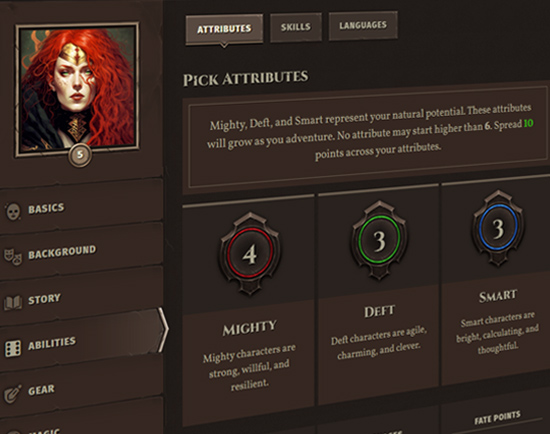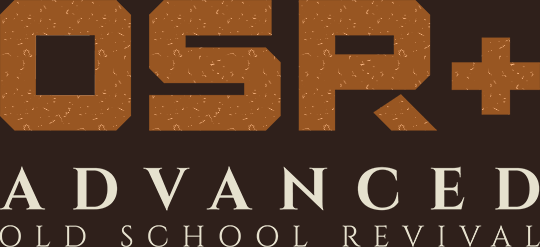Stances may look suspiciously like feats, which the philosophy of OSR+ is opposed to. This section describes the raison d'être of stances and how they differ from feats in their design intent.
What are Feats?
In many modern trad games, feats are codified things you can do that receive mechanical advantages when you push a button on your character sheet to activate them. There are a few problems with feats as a mechanic in RPGs when it comes to old school play:
- Feats are usually non-diegetic mechanics. When all a feat does is grant a modifier to a roll, giving it an evocative name ("Elven Accuracy") is not enough to change the fact that the feat is a purely mechanical thing that has no real basis in the fiction.
- Players end up scouring their list of feats to see if there’s some defined action that solves their problem, instead of thinking fiction-first and then applying a relevant feat to the action they conceived of taking. This leads to button-pushing like in a video game, rather than an interrogation of the fiction.
- Feats oftentimes describe a maneuver that, at least from a fictional perspective, anyone should be able to attempt. Even though the feat confers special mechanical bonuses for activating it, the GM has to be careful not to yield rulings where the special circumstances of the feat are allowed through the normal course of play, otherwise he risks invalidating the benefits of the feat for the players who invested in it.
Example of the Feat Trap
Consider a made-up "High Jump" feat that confers advantage when leaping. If any other player attempts to high jump, the GM has to remember to consistently penalize the normal action in some way, otherwise the High Jumper will feel like his feat is redundant. Even though the High Jump feat does give the high jumper an edge (advantage), it's often not enough to simply rule that a character who attempts to high jump rolls normally, because there may be other ways to receive advantage while attempting the action: having advantage conferred by an attribute, for example, or by the situational context.
Therefore, in order for the player with the feat to be differentiated from the one without it, we need feats to do something for the player's character concept, not just inflate the numbers.
Designing Stances
Stances are designed to be evocative first, and then offer some mechanical benefit as a result of that evocativeness.
As a result, stances necessarily have to be A) less powerful than talents, techniques, and kit abilities and B) less powerful than perks (which are purely mechanial enhancements to characters), however, they can be on par with what spells can do, which abide by A and B. Passive stances must also be more powerful than active ones, since only one passive stance can be slotted at a time as a focus, and remains unusable when not.
What Stances Can’t Do
- Stances don’t require MP to use, that way players aren’t losing the opportunity to use these new options over their other abilities. The only MP cost to players comes from switching focus in the middle of play. (And the rare stance that uses MP to scale its parameters.)
- Stances almost never apply advantage to rolls, and absolutely never apply numeric modifiers to rolls. This is the domain of talents and skills or story tags respectively.
- Stances don’t cause the die to explode on a 5 or 6. This is the domain of kits.
- Stances don't step on the toes of other defined abilities of classes or kits, or in the case where a stance enhances an ability derived from a particular class, it doesn't allow other classes to shortcut their way to that enhancement. This is why many combat stances say “you can’t benefit from this stance while casting spells,” so as to deter spellcasters from taking the stance.
What Stances Can Do
- Stances can invert a rule, so long as it’s contextual. For example, “you can move a melee space and act in the round" could become “you can move an encounter space and act in the round." In this way, stances let players fine tune their character concept.
- Each stance targets a specific category of play, similar to kits. This is so as to appeal to the different needs of different classes in the same way kits are derived from classes, in every game mode.
- Each stance confers a single flat ability rather than multiple abilities (like kits do).
Stance Anatomy
Consider the following stances:
Bonus Attack
Whether by mighty cleave, deft riposte, or smart sharpshooting, you enter the battlefield as a one-man army. Whenever you successfully attack an opponent within your reach, you may make a single attack as a bonus action in the round against a different opponent within a personal space of your victim, at disadvantage. You can’t benefit from this stance while casting spells.
Animal Friendship
You have always been a friend to the natural world, approaching its denizens with humility and respect. You may create a player advantage in your first interaction with a Wild animal or monster.
Legendary Lore
Your taste for great stories have transformed you into a gourmand of legends. When you use this stance, you may create a GM advantage concerning one of the following legendary subjects: magic, the dead, history, beastiaries, the astral veil, heroes, or the gods.
Breaking It Down
- The first sentence in a stance is always a description of the sort of character concept that would benefit from taking the stance. In Legendary Lore, this is a character who collects legends; in Bonus Attack, this is a fighter who likes to get into the middle of the fray; in Animal Friendship, this is a character who cares about the natural world in some way and respects wildlife as equals.
- The meat of the stance then describes the way in which it creates more freedom for the player to explore their character concept. More freedom here generally means making the character more competent at the sort of things they already do.
Creating Freedom Through Stances
Below are the four ways stances allow players to refine their character concepts:
By Negating Restrictions
Stances can negate a restriction imposed by some combination of the character's class or kit, or a limitation imposed by the core rules. Weapon Mastery, for example, removes the disadvantage that Fighter classes have on their second attack roll in the round, which is a restriction also imposed on some kits that grant the same.
By Creating Narrative Advantage
Stances can create narrative advantage or a story tag. This lets players take the reins of the fiction. Animal Friendship, for example, lets the player set the stage for the initial interaction with a Wild animal or monster.
BY Offering New Mechanical Options
Stances let players do something that isn't mechanically possible, but could make thematic sense if paired with other options. Sometimes this means porting over abilities reserved to spells, or minor abilities that are components of other techniques or kits. Read Magic, for example, imparts a minor ability usually reserved to spellcasters to open up character concepts like arcanists, who dabble in the arcane but are not themselves spellcasters.
Read Magic
Your familiarity with the arcane gives you an uncanny inkling about artifacts imbued with magic. When you use this stance, you may read an object's magical aura per a spellcaster's ability to detect magic, or identify a magic item even if you don't have an Arcana skill.
By Shortcuting Repetitive Checks
Stances can give players codified options that shortcut or obviate the need for certain checks frequently used by their character concept. For example, Eavesdrop, Move Silently, and Spider Climb do a combination of offering new mechanical options while also allowing them to skip mundane checks involved in run-of-the-mill roguish actions.
Spider Climb
Your masterful control over your balance and strength enables you to scale sheer surfaces with almost supernatural deft. As an action, you can climb even the most treacherous smooth surfaces without climbing gear, at twice the speed of the average adventurer, quickly and quietly (actions involving climbing that would ordinarily compromise your stealth status do not). Most checks you make that rely on climbing automatically succeed. If the GM requires a check, you may re-roll it if you fail.
 Armor
Armor Classes
Classes Conflicts
Conflicts Ethos
Ethos Flaws
Flaws Kits
Kits Maleficence
Maleficence Origins
Origins Shields
Shields Skills
Skills Spells
Spells Stances
Stances Tactics
Tactics Talents
Talents Treasure
Treasure Weapons
Weapons











 Hall of Heroes
Hall of Heroes Hall of Legends
Hall of Legends Dungeons & Flagons
Dungeons & Flagons